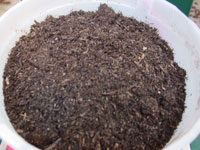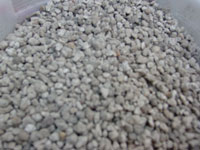Making Your Own Cactus Soil
"What type of soil should I plant my cactus in?"
Inevitably, the newcomer to growing cacti will be faced with this question. It is an appropriate question to ask as
succulent plants like cactus are not designed to grow under the same conditions as African Violets or Rose bushes.
The Growing Cacti section of this website further explains general
cultivation information on soil, water, and light. This article is intended to serve as example of one
method of creating a homemade cactus soil mix. I address both epi-cacti and desert cacti. As stated on the
Growing Cacti page, there is no mix that is best for all people
in all areas of the world growing all cacti. Therefore, it is my intent with this article to give an example of
one method for creating a cactus soil mix and not to insist that the reader follow this method exactly.
Before getting into creating a custom mix, I want to comment on commercially available "cactus" soils.
Beginner cactus growers often visit their local garden center when they are ready to repot their cactus for the first time. When they
do, they commonly find what looks like the exact answer to their needs. Several products are sold, such as
Scott's Miracle-Gro® Cactus, Palm and Citrus Soil or
Schultz Cactus, Palm & Citrus Potting Mix that claim to "provide superior growing conditions for all cacti
and other succulents". Experienced growers will assure you that this is not the case and that no soil mix
is ideal for all cacti species. Beyond that, these commercially available mixes are not just inadequate
for some cacti, they don't work for most cacti. These mixes are primarily a combination of sand and peat. Cacti soil
must not be perpetually wet or the roots will rot and possibly the entire plant. As a result, a cactus mix must be
allowed to dry out. To start with, the commercial mixes take too long to dry out especially in humid climates. However,
the worst part is that once the commercial mix dries out, it becomes very difficult to re-wet due to the nature of the
primary ingredient: that is peat. As a result, the water will sit on top of the pot and mostly drain down the inside of
the pot wall leaving the bulk of the root mass bone dry. All this is not to say that commercial cactus mixes
cannot be used with any success. I would not discourage anyone from including it as part of your total mix - especially
if you already purchased a bag of it. Keep in mind that peat and sand can be purchased separately at lower cost than the "Cactus soils" so if you really want
a sand/peat mix, you could make your own for less, but before doing so, read on!
Now that we've ruled out pre-made mixes as a stand alone solution for our cactus soil, lets look at one method of making a custom mix.
To start with, you will want a container large enough to hold all of your ingredients with enough room to stir them
together without spilling. I prefer to use plastic storage tubs (see far bottom left picture), but a wheel burrow could also work. You will also
want some sort of measuring device for consistency. This does not have to be precise, I use a 5 quart plastic
ice cream container. You can "eyeball" the amounts as well, but you will likely end up with inconsistent
proportions from batch to batch so I don't recommend that. A trowel or small shovel will also be useful for mixing
it all together.
 Good drainage is essential to prevent cactus roots from rotting, but some organic material is good for
nutrients and keeping the mix from drying out too quickly. I use a "standard" potting soil.
I try to avoid soils that have large chunks of "forest products", that is bark pieces and wood chips. While most potting soils are
a combination of "forest products" and peat, some are more like mulch than soil. These big chunks are avoided as they don't mix well with
the other components of the custom soil and eventually rot. I will
include one 5 quart bucket of this (or one part, depending on the amount I'm mixing). Next, I will include 2 buckets (or 2 parts) of pumice.
Pumice is a relatively light weight volcanic rock that is porous. Pumice is not available in many areas and while light, it
is still too heavy to mail order with shipping costs. Substitutes include perlite, non-soluble cat litter, aquatic plant soil or
Turface, NAPA oil dry #8822, chicken grit, or another similar substance. The goal is to provide an inorganic substance that allows water to pass through
the mix quickly, while at the same time making the mix somewhat "airy".
Good drainage is essential to prevent cactus roots from rotting, but some organic material is good for
nutrients and keeping the mix from drying out too quickly. I use a "standard" potting soil.
I try to avoid soils that have large chunks of "forest products", that is bark pieces and wood chips. While most potting soils are
a combination of "forest products" and peat, some are more like mulch than soil. These big chunks are avoided as they don't mix well with
the other components of the custom soil and eventually rot. I will
include one 5 quart bucket of this (or one part, depending on the amount I'm mixing). Next, I will include 2 buckets (or 2 parts) of pumice.
Pumice is a relatively light weight volcanic rock that is porous. Pumice is not available in many areas and while light, it
is still too heavy to mail order with shipping costs. Substitutes include perlite, non-soluble cat litter, aquatic plant soil or
Turface, NAPA oil dry #8822, chicken grit, or another similar substance. The goal is to provide an inorganic substance that allows water to pass through
the mix quickly, while at the same time making the mix somewhat "airy".

The third ingredient that I use is coir. Most people have never heard of coir and it is not a product that is easy
to find, even though it isn't that rare. Coir is made of shredded coconut husks and is a coarse, fibrous material that
is technically organic, but it is very slow to decompose. The purpose of adding coir to the cactus mix is to
help hold moisture and air while providing structure to the mix. Unlike peat, coir can easily be re-wet after it dries
out and it does not compact. If you cannot find coir, peat can be used as a substitute, but you may consider using less of
it. And since many potting soils have a high percentage of peat, you might just skip adding peat altogether - perhaps 60%
pummice/grit/litter to 40% potting soil. I use 1 bucket (or 1 part) of coir in my mix. Coir is sold in very tightly compressed bales. Before using it in
your mix, it has to be loosened up. This is hard work and while it can be done by hand, I found the best method
to be a wire mesh screen mounted on a wooden frame. I then break chunks off the bale and rub them on the screen. When this
is done, the coir expands to at least 3 times its original volume in the bale.
Now if I am making a mix for epiphytic cacti (epis), I do it much the same way, but instead of 2 buckets (2 parts) of
pumice, I will add only 1. Next, I will add 2 buckets (2 parts) of coarse "orchid bark". This is ground up
fir bark pieces that are marketed for use by orchid growers. The bark holds more water than the pumice, which the
epi cacti like. I notice that the roots also like to attach to the bark pieces. The bark also keeps the mix more airy
than simply adding more potting soil. Over time, the bark will break down and turn into soil. I find that the epi cacti
don't mind this at all, but will eventually appreciate a repotting. I would say it is best to repot every 2 to 4 years
depending on your specific conditions.

That concludes the main ingredients for the mix and one could stop at that and be satisfied with the mix. However, I go
a little further and in both the desert mix and the epi mix, I add a time-release fertilizer. The best known brand
of this is Osmocote® and that is the kind I have always used, although I am sure similar products would work fine.
I usually put about 3/4 of an inch in the bottom of the 5 quart ice cream pail and then dump it in. You'll have to figure out
how much that is if you are using a different measurement or just follow the recommendations on the label. Since this is
a time-released fertilizer, a newly potted plant will be fine for 6 months to a year, depending on how much you water it.
The epi cacti will obviously be on the short end of that. You will not likely be ready to repot at this time, so you will
want to remember to apply a fertilizer after this time. Aside from this fertilizer, I've also picked up the habit of
throwing in a scoop (1 trowel full) of bone meal. Admittedly, I'm not really sure of the effects on the cactus by adding this,
I just got the idea from another grower. His plants grow very well and it seems to be working well for me so far.
Once I have all the ingredients in my tub, I mix them with the garden trowel. If it is a larger batch, I use a small spade.
In the left picture below you can see the various ingredients ready to be mixed for an epi cactus mix. This gives you
some idea of the proportions used - keeping in mind that there is overlap in that tub. The second picture shows the
final result of a desert cactus mix. Note the absence of any bark pieces. The little yellow dots are the fertilizer. Finally,
it might seem in that mix that there is a 50:50 mix of soil to pumice, but remember 25% of the soil mix is coir. It
seems to lose its reddish brown color when all mixed in.
In conclusion, I reiterate that this mix is not the magic recipe that all growers should follow exactly. I
even vary this mix with certain cacti species that might prefer even less organic material. Keep in mind
also that there are many other factors such as, light, humidity, and temperature that affect the growth of your
cactus plants. These all should be considered along with availability of materials when you set about creating
your own mix. Don't be afraid to experiment as that is half the fun! It is my hope that this article will
provide the reader with a "better feel" for mixing up a custom batch of cactus soil.
Author: Daiv Freeman
|